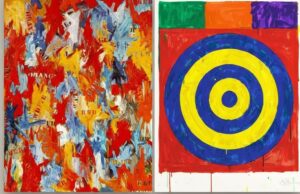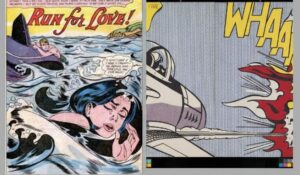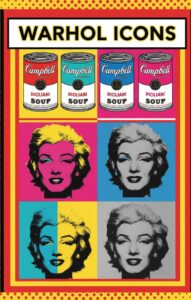Pop Goes the Art: How Pop Culture Took Over the Gallery Wall
Throughout history, art has always been considered a serious and exclusive club with rigid lines and rules on what is accepted. Art was seen as a way of expressing thoughts, ideas, and the world. This classic art, often referred to as ‘high art’, was the only popularly accepted form of art. Even when different art styles and art movements emerged, art retained its innate characteristic of being thoughtful, exclusive and often with inaccessible meaning.
But then, in a glorious explosion of colour and commerce, came Pop Art. It was loud, it was common, it was everywhere, and it redefined what art could be.
Swipe through a magazine, browse your Instagram feed, or glance at the cereal box on your breakfast table—and you’ll find traces of Pop Art. The Pop Art movement was a cultural mirror, reflecting the post-war, consumer-driven world on itself with a playful wink and an undeniable punch.
In this blog, we’ll explore the origins of Pop Art, what defines it, how it exists all around us, who in India is carrying the torch, and how you can join the art journey with the upcoming Giftex Modern & Contemporary Art Auction this November. Your art journey begins here.

What is Pop Art? A Bold Definition
Pop Art (short for Popular Art) is a colourful and exciting art movement. At its core, Pop Art is an art movement that uses imagery from popular culture—advertising, news, comics, mass media, and everyday objects—and brings them into the realm of “fine art”.
Key facets:
- It takes widely-recognisable images (cans of soup, comic strips, corporate logos) and re-presents them as art.
- It often uses bright, bold colours, simplified forms, mechanical reproduction (screen-printing) and repetition.
Because of all this, Pop Art also reminds us that art isn’t just for galleries—it’s in magazines, billboards, packaging, and in our everyday media feed.
https://www.youtube.com/watch?v=6qr7cdpGDRo
Video Credit: nationalgalleries @nationalgalleriesofscotland
Why Is It Called Pop Art?

Pop Art or Popular Art movement takes its name from the subject matter that inspired it: Film, comics, commercials, and other forms of popular culture. Pop artists believed that art taught in schools and exhibited in museums no longer represented the real world.
Pop artists turned to the imagery of popular culture—mass media, advertising, comic books, product packaging, and Hollywood celebrity culture—as their primary subject matter.
By elevating the mundane and commercial to the status of fine art, the movement consciously blurred the lines between “high art” and “low culture.”
Origins of Pop Art

The roots of Pop Art trace to two major geographies: Britain and the United States.
In Britain, a group called the Independent Group (early 1950s) at the Institute of Contemporary Art in London began meeting to discuss the rise of consumer culture, mass media, movies, comics—how popular culture was reshaping the world.
This group included some well-known Pop Art artists, like:
- Eduardo Paolozzi and his work, I was a Rich Man’s Plaything (1947), a collage made up of clippings,
- Richard Hamilton and his work, Just what is it that makes today’s homes so different, so appealing? (1956), a Pop Art collage.
In the US, artists rejected Abstract Expressionism in favour of art closer in spirit to Dadaism and Neo-Dadaism.
Characteristics of Pop Art?

What makes a painting or piece clearly Pop Art? Here are some common characteristics:
- Popular cultural imagery – comic books, celebrities, advertising, logos.
- Bright, bold colours / graphic aesthetic – very visual, strong contrasts.
- Mass-production techniques or references – screen-printing, repetition, repetition of image (think Andy Warhol’s soup cans).
- Blending high and low culture – acknowledging that pop culture can be art, and art can be casual.
- Everyday objects elevated to art – consumer goods, mundane items, signage become subjects.
Pop Art Styles
Here are different flavours of Pop Art with illustrative examples:
- Neo-Dada

Neo-Dadaism laid the groundwork for Pop Art. Artists began using found or known objects in their works, breaking down barriers between art and everyday life. It was art made out of the real world, not detached from it.
Example: Jasper Johns, whose paintings depicted “things the mind already knows,” like flags, targets, or numbers, forcing viewers to rethink the ordinary.
- Collage| Britain Pop Art
Pop Art and collage are inseparable. The movement loved cutting, pasting, and remixing images from magazines, ads, and comics.
Key Artists: Famous Britain Pop artists like Richard Hamilton and Eduardo Paolozzi of turned collage into one of Pop Art’s most recognisable languages.
Example: Hamilton’s Just What Is It That Makes Today’s Homes So Different, So Appealing? (1956) – a living room full of pop culture symbols, TV ads, and idealised consumer dreams. Collage mirrored the flood of media and marketing shaping post-war life—an early visual mash-up before the digital era.
- Pulp Culture

Pulp Culture Art imitates the aesthetic of another medium—especially comic books, pulp magazines, and printed graphics—and re-creates it on canvas or other surfaces.
Example: Roy Lichtenstein’s comic-style paintings like Whaam! (1963) and Drowning Girl (1963) capture the bold outlines, halftone dots, and drama of comic panels blown up to heroic scale.
- American Pop Art

When most people picture Pop Art, this is what they see. Bright, brash, and media-savvy, American Pop Art celebrated and critiqued consumerism at the same time.
Key Artists: Andy Warhol, Roy Lichtenstein, Claes Oldenburg, Tom Wesselmann.
Examples: Warhol’s Campbell’s Soup Cans (1962) and Marilyn Diptych (1962) turned everyday goods and celebrities into icons. Oldenburg’s oversized sculptures of burgers and household objects made the mundane monumental.
- Contemporary / Neo-Pop Art

The Pop Art attitude never disappeared—it just evolved. Contemporary or Neo-Pop Art picks up the legacy, remixing pop culture through digital tools, installations, and global influences.
Example: Takashi Murakami’s “Superflat” style blends anime, consumerism, and fine art into vibrant worlds. Jeff Koons’s shiny balloon animals or Yayoi Kusama’s dot-covered spaces turn commercial polish into high art.
In India: Artists like Sanuj Birla, known for his superhero and comic-themed art, add depth and humour to the Pop Art movement.
Indian Pop Art & Indian Artists
Pop Art’s embrace of popular culture found a unique resonance in India, a country defined by its vibrant, chaotic, and utterly pervasive mass culture. Indian artists weren’t reacting to American commercialism; they were immersed in a visual world of Bollywood posters, religious calendar art, street signage, and local advertisements.
Indian Pop Art takes the movement’s core principle and applies it to a uniquely Indian context. More broadly, Indian contemporary artists “redefining Pop Art in India” are using Bollywood, comics, street culture, neon colours and popular culture references.
Indian Pop Artists
- Sanuj Birla: A self-taught artist whose work draws inspiration from superheroes, cartoons, and other mass media icons.
- Suryakant Lokhande: A multimedia artist whose work is a fusion of rural and urban cultures. He often uses unconventional materials and incorporates pop culture influences.
- Shilpa Gupta: Works at the intersection of art and social inquiry, using video, sound, text, and interactive installations to explore how borders (nationality, language, psychological) shape our lives.
- Subodh Gupta: Well-known for using everyday objects and exploring themes of globalisation, urbanisation, and identity in his innovative sculptures and installations.
Also Read: Suryakant Lokhande: Celebrated Pop Artist of India
The Giftex Modern & Contemporary Art Auction
Looking to start your art journey? Or perhaps add another masterpiece to your collection?
Then the upcoming Giftex Modern & Contemporary Art Auction this November is a perfect opportunity. This auction is a spectacular showcase where the legacy of modern masters meets the innovative edge of today’s emerging talent.
Why you shouldn’t miss it
- It features both new artists and established names in the Indian modern/contemporary art space.
- Being an online auction house, Giftex makes access easier with online bidding from home, exploring lots, and building your knowledge.
- It’s a chance to jump in early and engage with art before it rises further in visibility and value.
Pop Art’s Enduring Legacy
Pop Art started as a bold statement: everyday culture matters. It transformed images of consumer goods, comics, and icons into visual art with impact—and in the process, changed how we perceive culture, media, and art itself. From Britain and the U.S. in the mid-20th century to the streets of Mumbai and Delhi today, Pop’s legacy is everywhere. From the vibrant, repetitive patterns on a can of soda to the striking portraits of a Bollywood star, Pop Art continues to colour our world. Embrace the bold, the bright, and the popular—because in the world of Pop Art, everything is a masterpiece waiting to be seen.






